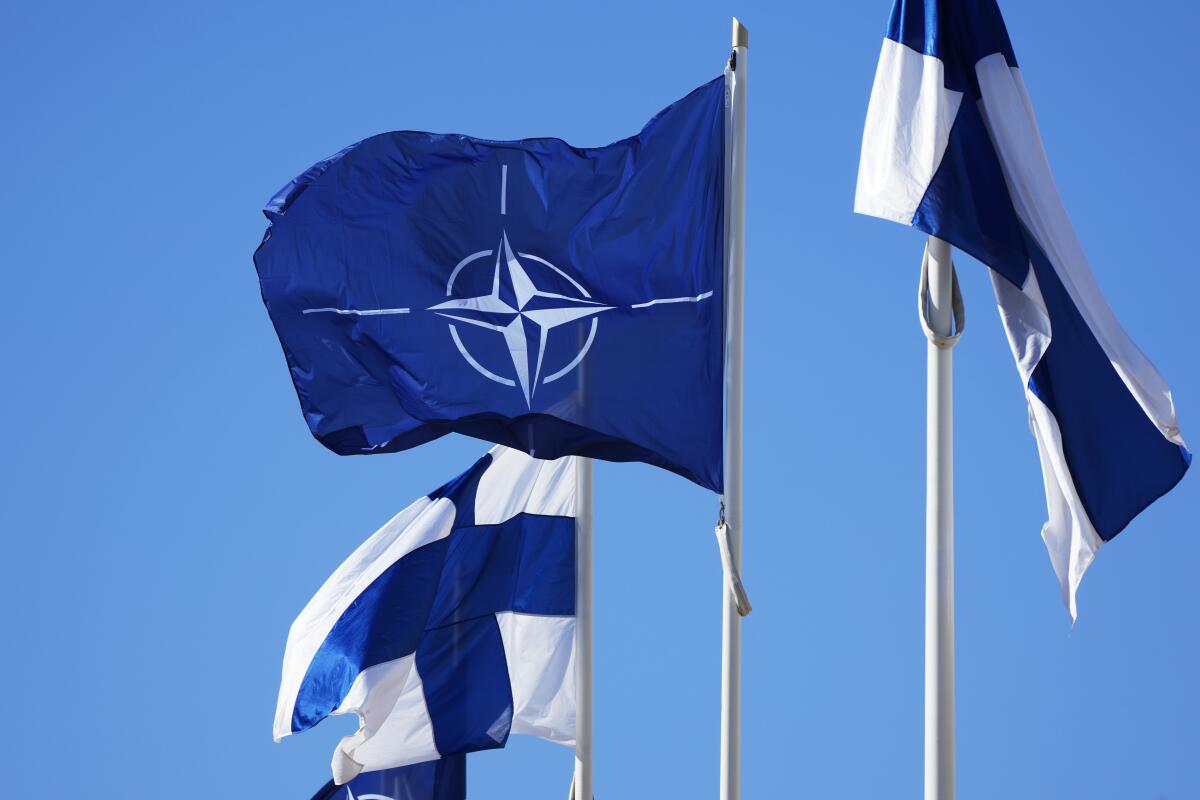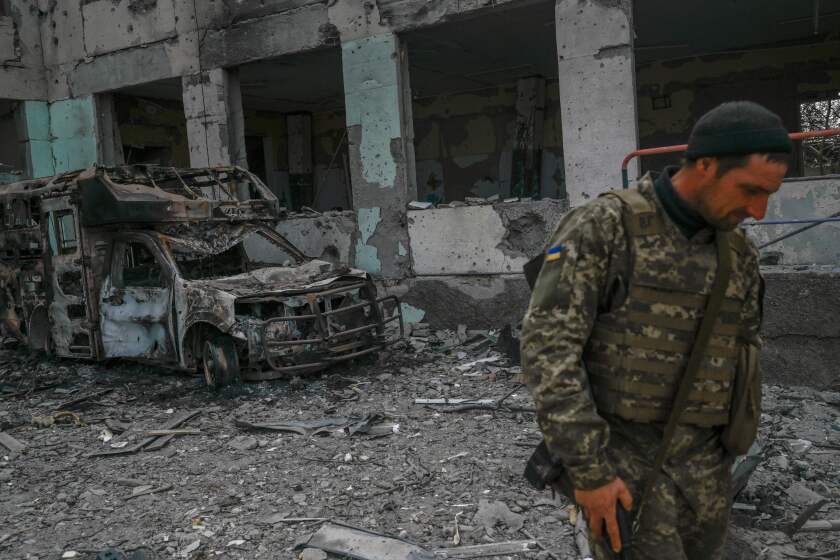Opinion: Now that Finland is part of NATO, can it help Ukraine?

- Share via
Officials at the North Atlantic Treaty Organization were celebrating at their headquarters in Brussels on Tuesday as the alliance welcomed Finland into its fold. In joining NATO, Finland has abandoned a 75-year tradition of military neutrality, throwing its lot in with the West against an increasingly isolated Russia.
The announcement is undoubtedly a black eye for Russian President Vladimir Putin, as his neighbor takes a side. But U.S. and European policymakers should not exaggerate what’s to come. NATO expansion is not a panacea. It will neither resolve the war in Ukraine nor fix the more serious underlying problems of European defense.
This week’s accession ceremony allowed policymakers to take a victory lap. Secretary of State Anthony Blinken, in attendance to receive Finland’s accession documents, noted that the alliance is now “more united than ever,” along with an off-handed remark that perhaps “this is the one thing we can thank Mr. Putin for.” British Prime Minister Rishi Sunak went further, arguing that Finland’s NATO membership “makes every one of us safer,” while German Chancellor Olaf Scholz described the event as a “victory for transatlantic security.”
NATO nations have remained remarkably united in their support for Kyiv. Lopsided economic assistance could break it down.
Finland was less controversial to NATO members than some of the other countries that have sought membership in recent years, such as Ukraine or Georgia. Even critics of expanding NATO tend to acknowledge that Finland has a long history of territorial self-defense. The nation spends adequate amounts on its military and is already somewhat integrated with nearby NATO member states.
Yet there are downsides: The length of NATO’s border with Russia has now almost doubled. Finland shares an 800-mile border with Russia, raising NATO’s risks of direct confrontation with Russia. As fighting continues into its second year in Ukraine, Finland is already an ardent supporter of Ukraine. It has contributed large sums and military equipment — around 900 million euros so far, plus 400 million euros in future commitments — while providing strong political backing for Ukrainian President Volodymyr Zelensky’s government. It will not bring significantly more funds or ammunition to the fight as a NATO member. Western leaders have overstated the extent to which Finland’s military power can beef up efforts against Russia.
Instead, the conflict is increasingly dependent on manpower and ammunition constraints on both sides, as the fighting intensifies over small areas of the map. The Russians have poured men and equipment into a relatively ineffectual campaign in Bakhmut in recent months, and it is not yet clear if Ukraine’s widely expected spring offensive can seize back significant territory. Many discussions in European capitals seem resigned to a long war, a stalemate or an informal armistice.
NATO’s expansion to Finland also doesn’t do much to improve European defense more broadly. Observers are right that Finland offers an example of the kind of resilient, defensive mindset that some members of the alliance badly need. But after the shock of last year’s invasion of Ukraine, many European states are falling back into old habits: relying on the U.S. to provide on-the-ground security in Eastern Europe, failing to develop appropriate military forces, and defaulting to protectionism rather than building a common European defense-industrial base.
Some worry that the “Zeitenwende” — the much-praised 2022 shift in European security attitudes — has yielded some increased spending from European states but little in the way of genuine policy shifts. And the delay of Sweden’s joining NATO serves to highlight the alliance’s ongoing problems with internal cohesion on some issues. NATO members are on board with support for Ukraine in its war against Russia, but often have divergent views on other security matters.
This might all sound like a petty complaint. After all, who can blame Western policymakers for wanting to highlight a win in the current environment? And surely, critics would argue, no one could possibly expect NATO expansion to a new member state to fix all of the alliance’s internal squabbles.
Ukraine is taking back land that Russia had seized. Neither side seems ready to give up, but is there a fig leaf to offer Russia to end the war?
Even so, it’s worth noting that NATO has a history of substituting expansion for genuine problem-solving. Indeed, for the two decades following the collapse of the Soviet Union, NATO’s leaders punted on questions about the alliance’s future, its purpose and its military capabilities in favor of a focus on expansion to include the nations of Eastern Europe. Until at least 2008, debates about expansion were a central focus of many of the alliance’s summits.
There’s already talk about negotiations to admit Ukraine to NATO in some form after the war. Polish President Andrzej Duda, playing host to Zelensky this week in Warsaw, promised to raise the issue of security guarantees for Ukraine at the next NATO summit.
For now, NATO’s leaders have more pressing issues to discuss, including how to handle the dwindling European stockpiles of arms and how the war in Ukraine may end. Finland’s membership won’t answer those questions.
Emma Ashford is a senior fellow at the Stimson Center and an adjunct professor in Georgetown University’s Security Studies Program. @EmmaMAshford
More to Read
A cure for the common opinion
Get thought-provoking perspectives with our weekly newsletter.
You may occasionally receive promotional content from the Los Angeles Times.











